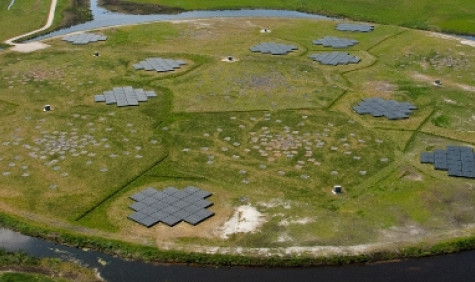"The LOFAR telescope had to meet at least two important criteria. The first is a high degree of flexibility. Secondly, the telescope had to be highly sensitive. "
Space research with Grid-infrastructure
For years, the well-known radio telescopes in Dwingeloo and Westerbork allowed us to conduct research on the Milky Way and outer reaches of the universe. However, these telescopes have their limitations. Stichting ASTRON in Dwingeloo has therefore been working hard to develop their successor: the LOFAR (Low Frequency Array) telescope.
Stichting ASTRON
Stichting ASTRON is the Netherlands Institute for Radio Astronomy. The institute consists of three pillars: Research and Development, Astronomy and the Radio Observatory. The LOFAR telescope, largely designed and developed by ASTRON, is now operational. The Radio Observatory manages the telescope on behalf of the International LOFAR Telescope (ILT) in addition to its responsibility for the Westerbork Synthesis Radio Telescope (WSRT), and provides LOFAR data to the scientific community. Hanno Holties works as a system engineer at the Radio Observatory.
Thousands of small antennas
Holties explains: ”The LOFAR telescope had to meet at least two important criteria. The first is a high degree of flexibility. Traditional telescopes only allow us to observe a limited part of the universe at a time, and their mechanical components require a great deal of maintenance. LOFAR is made up of thousands of small antennas in stations throughout the Netherlands. All these antennas are connected electronically. This enables LOFAR to continually monitor the entire visible universe, and respond quickly as soon as an event (such as an exploding star) takes place. Secondly, the telescope had to be highly sensitive. Thanks to its extensive network of antennas, LOFAR can pick up a large spectrum of radio signals.”
Grid infrastructure
All radio signals are transmitted to a central processing unit in Groningen via a fiber network. Here, the first round of qualitative processing is conducted, and the data is stored temporarily. LOFAR’s computer systems do not allow for long-term data storage. Amongst other facilities, ASTRON uses SURF’s Grid infrastructure for long-term storage and data analysis. Compressed data is transferred to SURF in Amsterdam via a fiber optic network, where it is stored on disks and tapes.
Portal
Radio astronomers are accustomed to accessing data immediately after an observation, so that they can then process it on a workstation. However, the scale of operations at LOFAR is so great that this is no longer possible. Although the Grid infrastructure offers the necessary facilities, processing on this system does require specialist knowledge. This is why ASTRON aims to offer astronomers access to the relevant data via a portal. Scientists can then specify which form of processing they wish to carry out, after which the data will be processed in the Grid infrastructure. This means scientists do not need to have specialized knowledge of the infrastructure’s inner workings.
"SKA consists of mini receivers and static antennas comparable to those used by LOFAR. We will be applying the lessons we are currently learning at LOFAR in the development of the SKA telescope."
The future: the SKA telescope
SURFsara and ASTRON have been engaged in intensive and constructive collaboration on the LOFAR project since 2008. This collaboration offers perspective for the future in terms of the Netherlands’ role in SKA (Square Kilometer Array), an international project. The technologies developed by LOFAR are a good learning process for SKA. Holties: ”SKA consists of mini receivers and static antennas comparable to those used by LOFAR. However, the frequency and scale is so much larger that the resulting radio astronomy data can only be measured in Exabytes and Exaflops. Data processing and storage thus represents a major challenge. We will be applying the lessons we are currently learning at LOFAR in the development of the SKA telescope."

